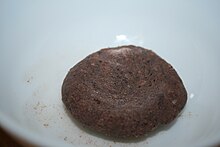Ngapi (Burmese: ငါးပိ [ŋəpḭ], lit. 'pressed fish') is a pungent paste made of either fish or shrimp used in Burmese cuisine. Ngapi is typically made by fermenting fish or shrimp that is salted and ground then sundried. Like cheese, it can be distinguished based on main ingredient and regional origin. Ngapi can be distinguished by the type of fish used to make it. Ngapi can come from whole fish (such as ngapi kaung), from small fish (hmyin ngapi) or from prawns (seinza ngapi). Ngapi is a main ingredient of Lower Burmese cooking and is used as a condiment or additive in most dishes. Raw ngapi, with some exceptions, is not intended for direct consumption.

Raw ngapi
| |
| Alternative names | ငါးပိ |
|---|---|
| Type | Paste |
| Place of origin | Myanmar |
| Associated cuisine | Burmese cuisine |
| Main ingredients | Fish or shrimp |
| Similar dishes | Ngachin, Shrimp paste, pla ra, padaek, prahok, bagoong, shiokara |
Similar fermented seafood pastes are common across the Southeast Asian cuisines, notably Malay belacan and Thai kapi and pla ra, Lao padaek, and Khmer prahok.
Ngapi is a compound word in the Burmese language, literally meaning "pressed fish".[1] The Burmese term was borrowed into the Thai, Lao, and Khmer languages as "kapi", and now refers to shrimp paste, not fish paste, in those languages. However, in Bangladesh their shrimp paste is called "nappi".[1] In addition, due to the Burmese migrants' introduction of ngapi in Mizoram, it is called "nghapih" using the Mizo orthography but refers to shrimp paste.[2]
In English, ngapi was previously spelt in numerous ways, among them ngapee,[3] nga-pee[4] and gnapee.[5]
Ngapi has a long history in Myanmar, as continental Southeast Asia has the widest variety of fermented fish products.[1] The earliest extant record referencing "ngapi" is a Mon stone inscription dating to the 1st century CE.[unreliable source?] [6] Ngapi makers are also listed in Burmese stone and marble inscriptions dating to 1100s to 1400s.[6] The Mon established a trading pattern for ngapi by the 1400s, trading ngapi, salt, and rice in exchange for rubies, benzoin, and musk from the Bamars in Upper Myanmar.[6] The trade of ngapi was economically significant in pre-colonial era, and was submitted as a tributary gift by Mon kingdoms to the Konbaung kingdom. In 1880, Pho Hlaing, a Konbaung era scholar, noted the purported health effects of ngapi, including enhanced diffusion and digestion of phlegm and bile in the Utubojanasaṅgaha treatise (ဥတုဗောဇနသင်္ဂဟကျမ်း).[6] During British rule in Burma, European observers noted that the importance of ngapi in Burmese cuisine, and characterized its smell as "very self-offensive" and "offensive".[7][8]
Ngapi is a main ingredient of Lower Burmese cuisine from maritime coastal regions in the west and the south. It is not a main ingredient in traditional Upper Burmese (Burman, Shan, etc.) cuisines, although improved transportation in the modern era has helped increase ngapi's popularity in Upper Myanmar. It is used in a wide array of dishes and is eaten in myriad ways: it can be eaten on its own, such as baked or roasted ngapi, as a watery preparation called ngapi yay (ငါးပိရည် [ŋəpḭjè]), as a salad, as a pounded mixture with chili, or fried like balachaung. It is also used as a soup base and in main dishes.
The versatility of ngapi is reflected in the variety of methods the people of Myanmar have developed to consume ngapi.
Asngapi is made from fish, shrimp or beans, it is a source of protein. The ngapi made from marine fish and prawns also provide a source of iodine (which is abundant in all seafood): this may possibly be beneficial for those inland consumers whose diet may be iodine-deficient and who do not have access to iodized salt. Due to the high salt content which goes into the preparation, ngapi, like all salt-rich foods, should be consumed in moderation in patients with salt-sensitive hypertension.